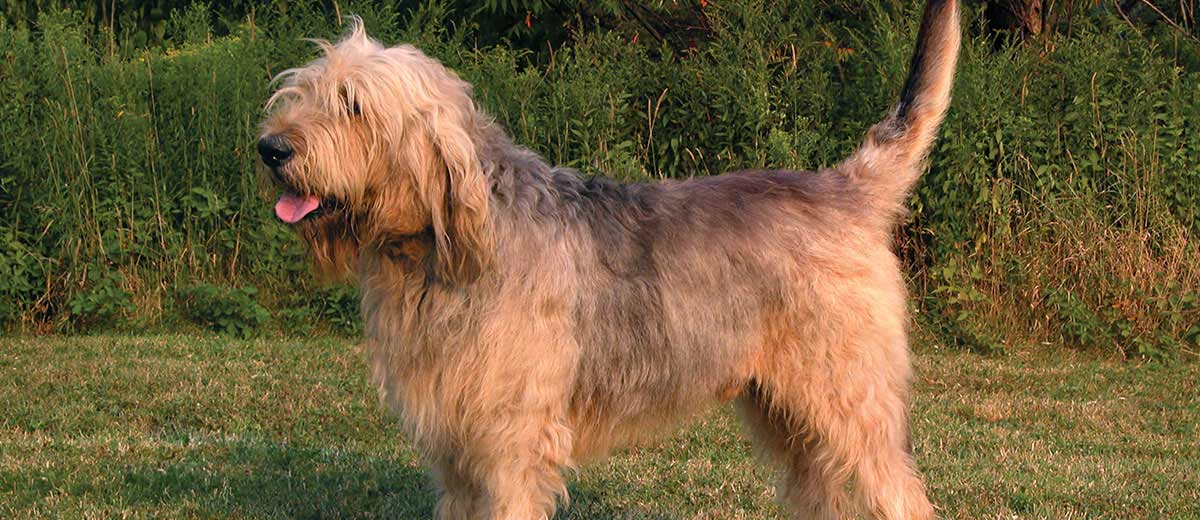Otterhound
Big and boisterous, the Otterhound is a large scent hound with a stocky build that is slightly longer than tall. Their signature shaggy double coat consists of a rough, coarse outer combined with an oily, soft, and wooly undercoat that allows them to easily work in water, regardless of the weather. Their large feet and wide muzzle make them agile trailers that can easily maneuver almost any terrain.
Breed characteristics carousel
Learn More
Need to Know
- Suitable for experienced owners
- Extra training required
- Enjoys vigorous walks
- Can be left alone occasionally with training
- Large dog
- Some drool
- Requires frequent grooming
- Chatty and vocal dog
- Barks and alerts to visitors/anything unusual
- Generally friendly with other dogs
- May need additional training to live with other pets
- May need additional supervision to live with children
- Needs a large yard, preferably in rural areas
- AKC Registered Breed

Personality
Otterhounds are amiable, easygoing, and affectionate dogs. They can be exuberant and have a great sense of humor. The Otterhound dog breed gets along well with their family and other dogs as they were developed to work in packs. Like most hounds, they are a loyal breed who are stubborn and might have selective hearing once on a scent. At home, they are quiet and loving and enjoy being around people.
Originally bred to hunt otters and protect fish in ponds, the earliest record of Otterhounds dates back to Henry II in the 12th century. They found favor in royal courts for their large and noble appearance. King Edward II and Queen Elizabeth I were known as the First Master and Lady Master of Otterhounds. The first Otterhound made its way to America at the beginning of the 20th century and remains rare.
The ideal Otterhound owner loves water and does not mind the mess that might come with owning a dog that also loves water. Owners should be patient and understand the Otterhound’s hound instincts. Ideally, owners will live in a rural area and have a large yard with access to a body of water to allow the dog to do what it does best—swim.
Otterhound puppies need to be carefully exercised so that they do not overexert themselves and cause injuries. They are active and enjoy exercise but prefer to expend their energy chasing scents and swimming than they do with more traditional forms of enrichment.
Otterhound dogs need ample space to dry off after a swim. A secure yard with a fence that is at least 6 feet tall so that they cannot jump over it is also necessary. This breed is not suited to city life.
Otterhounds should not be bathed as soaps and shampoos can remove necessary oil from their waterproof coat and can lead to itchy, irritated skin. They will need brushing a few times a week. Owners should also check their coats and paws for dirt and debris that can be picked up on walks or during swims.
The sensitive Otterhound responds best to positive, reward-based training, especially any involving food as they are food motivated. They love praise, so applying this to the training process can be very helpful. Like most hounds, they might struggle with recall and obedience when their noses are engaged—any scent they pick up will take priority over anything an owner is asking them to do.
Otterhounds can make a great pet for the right family. Owners should be active and enjoy being outdoors, even in terrible weather. The Otterhound dog breed is large and a little clumsy, so families with older children are best.
The cost of an Otterhound from a breeder is significantly more than the cost of adopting one from a local shelter or rescue. The adoption fee usually covers additional items such as spaying or neutering, vaccines, and microchipping.

Learn more about feeding and caring for your Otterhound on Purina.
Did You Know?
- Despite being one of England’s most ancient breeds, the Otterhound is now endangered and is said to be rarer than the Giant Panda, with less than 50 new puppies registered per year for the last 5 years.
- Otterhounds submerge their whole nose underwater and will blow bubbles.
